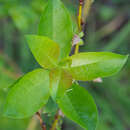en
names in breadcrumbs


Salix starkeana is a small, prostrate shrub from the genus of willows (Salix) with red-brown to purple-red, bare branches and olive-green leaf tops. The natural range of the species is in Europe and in northern Asia.
The pale willow is up to 1 meter high, prostrate to arching ascending shrub with thin, red-brown to purple-red, bare branches. Young shoots are initially hairy and shed later. The leaves are broadly elliptic to semi-kidney-shaped stipules . The petiole is about 5 millimeters long. The leaf blade is 5 to 7 centimeters long, 1.5 to 2 centimeters wide, broadly lanceolate to ovoid or obovate, suddenly pointed, with a narrowed base and a glandular serrated leaf margin. The upper side of the leaf is initially slightly hairy, later balding, weakly shiny, olive-green and nervous. The underside is bare and deep to blue-green. Six to eight pairs of nerves are formed.[1][2]
1 to 3 centimeters long, elliptical catkins are formed as inflorescences on a 1 centimeter long stalk covered with leaves. The bracts are yellowish or brownish, glabrous and long bearded only on the edge. A nectar gland is formed per flower. Male flowers have two almost bare stamens . The ovary of female flowers is long-stalked and densely hairy. The stylus is formed clearly, the scar is divided gabelig. The pale willow flowers from March to April at the same time as the leaves shoot.[1][2]
The number of chromosomes is 2n = 38 or 44.[3]
The natural distribution area extends from Northern Europe (Finland, Norway, Sweden) through Central Europe (Germany, Poland, Czech Republic, Slovakia) to Romania and the far east of Russia ( Siberia , Primorye region ). [5] In Germany there are stocks in Bavaria and Baden-Württemberg , the populations in Bavaria being listed as threatened with extinction and in Baden-Württemberg as endangered.[4] The pale willow grows in bogs and swamp areas on boggy and wet peaty soils in sunny to light-shaded locations. The circulation area becomes the winter hardiness zone5a assigned to mean annual minimum temperatures of −28.8 to −26.0 °C (−20 to −15 °F).[1]
The pale willow thrives in Central Europe in cold winter, frost-rich areas. It is a character species of the Polygono-viviparo-Nestedum sagittalis from the Violion caninae association, but also occurs in the Molinion association or in the Betulo-Salicetum repentis.[3]
The pale willow (Salix starkeana) is a species from the genus of willows (Salix) in the willow family (Salicaceae).[5] It was described in 1806 by Carl Ludwig Willdenow.[5] The generic name Salix comes from Latin and was already used by the Romans for various types of willow.[6] A synonym of the species is Salix livida Wahlenb. Wahlenb.[2]
Salix starkeana is a small, prostrate shrub from the genus of willows (Salix) with red-brown to purple-red, bare branches and olive-green leaf tops. The natural range of the species is in Europe and in northern Asia.